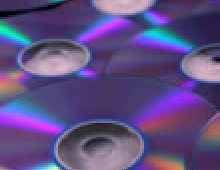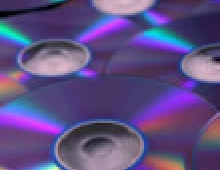
Optical Media Wars: DVD vs. SACD
Technologies developed after Compact Disc standards were established make much higher data densities possible on standard 12 cm discs.
New formats using smaller pit and track geometries as well as shorter-wavelength lasers allow several times the amount of data to be stored than was possible previously. That higher density in writing laser data opened the door for new standards, which in turn loosened the grip of CD patent holders Sony and Philips, allowing other companies to jump into the fray.
Toshiba became the leader in the formation of the DVD Forum (www.dvdforum.org), an association of more than 200 companies that guides the development of DVD formats. Not to be outdone, Sony and Philips have developed their own set of competing standards for audio, recordable DVD, and other emerging high-definition formats. The result is two groups of specifications for high-density media. The first, developed by the DVD Forum, consists of DVD-Video, DVD-Audio, DVD-R/RW, and DVD-RAM. The second, developed by Sony-Philips, consists of Super Audio CD (SACD), DVD+R/RW, and Blu-ray Disc. (For more details, see the sidebar "For Your Information.")
Officially speaking, the letters DVD no longer stand for anything. They were originally an acronym for Digital Video Disc, but because DVDs were to be used for audio and data as well as video, the meaning was changed to Digital Versatile Disc. When that term failed to catch on, the DVD Forum decided that DVD would simply stand for DVD.
Oddly, the DVD Forum neglected to lock up legal ownership of the term DVD, leaving the Sony-Philips group free to use it for its own format. DVD is now used for various sometimes-incompatible DVD Forum formats as well as for the Sony-Philips DVD+RW format. Although the latter is not endorsed by the DVD Forum, most writers and readers manufactured today support it. Fig. 1 shows the structure of the DVD Forum specifications.
READ-ONLY FORMATS
The DVD Forum specification for read-only DVD discs consists of four books. The first book consists of the physical- and file-system specifications known as DVD-ROM. The other books, called application layers, set the standards for DVD-Video, DVD-Audio, and DVD-ENAV (a recently-released enhanced DVD specification). Those specifications allow DVD discs to be played on commercial DVD players. The DVD-Video application layer, for example, defines a set of compatible media data types (primarily MPEG-2 video and Dolby AC-3 audio), a structure for onscreen menus, and an elaborate set of tables and indexes for navigating to the material on the disc. That application layer makes possible mass-market DVDVideo with its elaborate feature set and high degree of player compatibility.
The physical specifications of DVD-ROM cover things such as gross dimensions, track pitch, and pit size.
The specification has options for one or two data layers and single- or double-sided discs, with capacities ranging from 4.7- to 14.7 GB. (The term layers here refers to physical layers on the disc, rather than layers as described in the previous paragraph.)
The file system describes the means of locating and accessing data using two forms of addressing. The first is based on sector offsets and is loaded when the disc spins up; the second, similar to the track addressing on audio CDs, is used by low-intelligence standalone players. The file system is also needed for computers to be able to read the discs, and the designers were careful to avoid the problems encountered with CD-ROM. The DVD file system is free of the major limitations in file naming and folder nesting of CDROM and is compatible with existing systems.
The DVD-ROM file system goes by the name ISO 9660/micro-UDF. The dual designation indicates that every DVD has two separate file systems. The data is not duplicated, but two sets of tables are provided to locate the data on the disc. A device reading the disc can use the set of file-system tables it understands. ISO 9660 is the CD standard and has backward compatibility. UDF stands for Universal Disc Format as defined by the Optical Storage Technology Association (OSTA). The "micro" designation indicates that DVD uses only part of UDF. Neither Windows nor Mac OS supported UDF initially, but now all major computer operating systems support it. Nevertheless, all DVD-format discs are required to support both ISO 9660 and micro-UDF.
DVD-Video is the textbook example of how to establish a format for market success. Technology companies and content providers were careful to define a robust feature set and to describe it in minute detail. That resulted in a remarkably smooth rollout, with few glitches in the design of players and production tools.
The feature set of DVD-Video is now well known, thanks to the many bonus-packed Hollywood DVD titles available for rental or purchase (see the table "DVD-Video Specifications"). For more detailed information on how DVD-Video works, check out the excellent summary at www.dvd-replica.com/DVD/index.php.
The development of DVD-Audio went far less smoothly than that of DVD-Video. A group of members of the DVD Forum interested in audio was relegated to work on the DVD-Audio format definition. Lacking the focus and motivation of the group that hammered out the video spec, the DVD-Audio group spent far too much time wrangling over competing agendas.
By the time a draft of the DVD-Audio spec was ready, downloading MP3 music files had rocked the music industry, and the DVD-Audio group had to rework its draft to beef up copy protection. When the full spec was finally released, interest at the major record labels had cooled, and titles (as well as the players to play them) were slow to arrive. In addition, consumers clearly valued the convenience and economy of CD over the superior fidelity of DVD. Furthermore, a competitor had emerged - Super Audio CD (SACD). (See the table "Feature Comparison of DVD-Audio and SACD" as well as the description of SACD later in this article.)
DVD RECORDABLE FORMATS
With recordable DVD, things get a bit confusing. The DVD Forum supports three variants of the DVD-R Write-Once format as well as two mutually incompatible rewritable formats, DVD-RW and DVD-RAM. To further confuse matters, the Sony-Philips rewritable disc format is named DVD+RW, even though it is not a DVD Forum format. I'll start with the write-once formats.
DVD Write-Once (DVD-R) is similar in principle and use to CD-R. Originally a professional medium for production houses and data-storage companies, DVD-R initially carried a high price tag - roughly $5,000 for the recorder and $20 or more for media. When the technology matured enough to lower prices, conflicting agendas emerged. The manufacturers of pro DVD-R drives and media were eager to keep their high profit margins, and copyright holders worried about rampant home copying of DVD-Video titles. That resulted in two DVD-R formats - one having two variants, and each differing in its compatibility with existing players.
The first DVD-R for Authoring format released to the professional market offered a capacity of 3.9 GB, compared with 4.7 GB for replicated discs. Although the capacity was less than they wanted, DVD-title producers were ready to pony up for any form of DVD-R they could get. When 4.7 GB recordable media became available, there were problems with player compatibility. As a result, both 3.9 GB and 4.7 GB versions of DVDR are used today.
DVD-R for Authoring still commands a premium price. It offers better player compatibility than formats available to the mass market, and it is free of copy restrictions. The default standard for holding capacity is 4.7 GB, but there are some older players that can't read the 4.7 GB discs. Media offering 3.9 GB remains available and is generally used for testing because it allows the latest features to be tested on the earliest DVD players. That is of particular importance for high-end Hollywood producers, who strive to obtain the broadest possible compatibility.
DVD-R for General has different reflectivity from DVD-R for Authoring and has reduced compatibility with older DVD players. When you record on a consumer-grade, write-once DVD, your discs should play on newer players but not necessarily on older ones.
DVD-R for General also uses the Serial Copy Management System (SCMS). With SCMS, a copy thus can be made of an original DVD, but during the copying process the DVD-R drive flips a bit in a special area of the disc. Trying to make a copy of the copy results in an error. Support of SCMS is mandated by the DVD Forum in all DVD-R drives that record to the General media.
DVD RERECORDABLE FORMATS
The DVD Forum specifies two formats for rerecordable discs: DVD-RW and DVD-RAM. As previously noted, DVD+RW, the other popular format of rerecordable high-density discs, is supported by Sony-Phillips (see the sidebar "Compatibility" for tips on what to look for in DVD burners).
DVD-RW, developed by Pioneer, uses phase-change media, which allows roughly 1,000 rewritings. The capacity of the disc is 4.7 GB. Recorded media are compatible with most DVD players and DVD-ROM drives currently sold. Because the reflectivity is similar, older drives may mistake the media for a dual-layer DVD disc.
DVD-RAM is different from other Forum-supported formats and is incompatible with most drives installed and sold. It uses phase-change technology and some magneto-optical features in a novel combination that offers fast rewritability with as many as 100,000 rewritings. The medium also has defect-management features for higher reliability.
DVD-RAM comes in two versions. The original format supports only 2.6 GB of data on a single-sided disc. Version 1.0 increases the capacity to 4.7 GB on a one-sided disc; double-sided media is also available.
DVD-RAM discs come in a cartridge that protects the disc. The cartridge can be removed so the disc can be used in standard DVD players and DVD-ROM drives. Most existing players cannot read DVD-RAM discs, but that may change.
In spite of DVD-RAM's incompatibility with other DVD formats, it has found a niche because of its fast rewritability in large-scale database and transaction-management systems, where large disc changers can hold vast amounts of data. Video camcorders based on DVD-RAM have also begun to appear, and they often have sophisticated in-camera editing features.
As drives and media became more affordable, manufacturers wanted to produce set-top boxes that could record video and audio in real time, as the data is received over cable or air waves. That is now supported by the DVD Forum's recent rollout of real-time recording specifications for DVD-VR (video), DVD-AR (audio only), and DVD-SR (stream recording) approved by the DVD Forum in the fall of 2001. So far, the latter two haven't seen much use in the field.
SONY-PHILIPS STANDARDS
The DVD Forum maintains the original specifications of the DVD family, but Sony and Philips sustain and promote two DVD specifications outside the Forum: DVD+R and DVD+RW.
DVD+R and DVD+RW are based on CD-R and CD-RW technology. Sony-Philips claims that they are more compatible with existing players than DVD-R and DVD-RW are, but the format has never been able to win the blessing of the DVD Forum.
Super Audio CD is the DVD-like format of greatest interest to musicians. Whereas DVD-Audio is based on linear Pulse Code Modulation (PCM), SACD is based on a technology called Direct Stream Digital (DSD). DSD uses a single bit at a high sampling rate to indicate the rise and fall of a waveform rather than its absolute amplitude, as is the case with PCM. Sony maintains that DSD better reproduces the frequency and phase characteristics important to imaging and transient response.
SACD also includes physical watermarking for copyright protection. Called Pit Signal Processing (PSP), this method varies the width of the pits on the disc and is physically stamped into the disc. That is of great interest to record labels.
SACD provides backward compatibility with CD audio by using dual-layer disc technology (see Fig. 2). An SACD disc can be manufactured with a layer of SACD data and a layer of standard Red Book audio, readable by most CD and DVD players. The table "Feature Comparison of DVD-Audio and SACD" compares SACD and DVD-Audio. The most important point is that there is no way yet to create one-off SACD discs.
DVD-Video offers most of the benefits of interest (surround audio, better-than-CD fidelity, picture with music) to desktop musicians. Production tools for DVD-Video are readily available, and the discs play on a huge variety of players. Unless you're concerned with being on the absolute cutting edge of fidelity, my recommendation is to stick with DVD-Video for the present time.
The current focus of the DVD Forum's work is HD DVD, which uses refined technologies to increase capacity to the 15- to 40 GB range for higher-resolution video and audio. Currently, there are several contenders for the new standard. It's too early to predict the final outcome, but you can be sure that there will be HD DVD in the not-too-distant future.
COMPATIBILITY
Marketing hype aside, DVD burners increasingly support multiple formats. Here are some points to help you choose the right format. When shopping for a burner, check which formats it supports. More is better, but the list should definitely include DVD-R. If you're going to read the discs just on the same drive that burns them, you can choose a format based solely on cost. Aside from the more expensive DVD-R for Authoring, DVD-R for General is the most compatible format. However, some older drives cannot read it. Rewritable DVD, whether -RW or +RW, is compatible with fewer players than DVD-R is. DVD-RAM is compatible only with drives specifically designed to handle it.
Copyright 2004 by Primedia Business Magazines & Media, Inc.. All rights reserved.
From Electronic Musician/ITToolbox


















